Antonio Pujia

http://www.antoniopujia.com
Kunstart: Skulptur
Technik: Bronze
Stil: Klassische Moderne
Vita / Lebenslauf:
Antonio Pujia wird am 11. Juni 1929 in einem süditalienischen Dorf namens Polia geboren. Seine Eltern sind Vittorio Pujia und Maria Vallone. Schon in früher Kindheit zeigt er Interesse für das plastische Gestalten: er formt sein eigenes Spielzeug aus Ton vom Ufer eines nahe gelegenen Bachs.
Im Mai 1937 reist Antonio Pujia mit seiner Mutter und seiner älteren Schwester Carmela nach Argentinien. Dort werden sie von Vater Vittorio erwartet, der bereits ausgewandert war, als Antonio zwei Jahre alt war.
Gerade in Buenos Aires angekommen, beginnt Antonio Pujia die Schule. Bereits in der zweiten Klasse und noch mit Sprachschwierigkeiten im Spanischen beginnt er, die seine Aufmerksamkeit erregenden Gegenstände in seiner neuen Umgebung zeichnerich zu erfassen. Seine Zeichnung eines Zeitungs�verkäufers wird von der Lehrerin in der ganzen Schule herumgezeigt, was ihn mit Stolz erfüllt. Ansonsten hatte er eher Schwierigkeiten mit dem Lernen, aber erst sein Lehrer in der vierten Klasse schickt seine Mutter mit ihm zum Augenarzt. Dieser stellt eine starke Kurzsichtigkeit fest und Pujia wird zum Brillenträger.
Am Ende der sechsjährigen Grundschule berät der Klassenlehrer die Schüler bei der Wahl einer weiterführenden Schule. Antonio Pujia rät er zu einer Schule mit künstlerischer Orientierung. Schon allein von dem Klang des Namens escuela de bellas artes fasziniert, spricht Antonio seinen Eltern, dass er auf so eine Schule möchte. Damit stößt er zunächst beim Vater auf Ablehnung, der eine kaufmännische Orientierung für zukunftsträchtiger hält. Die Mutter schlägt sich jedoch auf seine Seite, und er meldet sich für die Aufnahmeprüfung in der Manuel Belgrano-Schule an. Am Tag der Prüfung wirde es ihm jedoch mulmig, als er merkt, dass die anderen Bewerber sich im Gegensatz zu ausgiebig auf die Prüfung vorbereitet haben, er dagegen überhaupt nicht. Dennoch besteht er und wird aufgenommen. In der Kunstschule fällt er zunehmend durch künstlerisches Talent und Fleiß auf. Gleichzeitig arbeitet er, um sich den Schulbesuch und im Anschluss das Kunststudium zu finanzieren. Dabei wählt er immer Arbeiten, die ihm neue Kenntnisse und Praxis im Umgang mit bildhauerischen Materialien ermöglichen, wie z.B. die Gips- und Gussformenherstellung. Die Ausbildungszeit erstreckt sich von 1943 bis 1954. Zu Pujias Lehrmeistern gehören namhafte Künstler wie Troiano Troiani, Alfredo Bigatti, Alberto Lagos und José Fioravanti. In ihren Ateliers arbeitet er auch als Assistent, ebenso bei Rogelio Yrurtia. Schließlich erwirbt er die Lehrbefähigung für Graphik an der staatlichen Kunstschule Escuela Nacional de Bellas Artes Prilidiano Pueyrredón und für Bildhauerei an der staatlichen Kunsthochschule Escuela Nacional Superior de Bellas Artes Ernesto de la Cárcova. Jahre später sollte Pujia die Höfe seines eigenen Schulateliers nach seinen Lehrmeistern benennen, um sie so zu ehren.
Pujia widmet sich immer intensiver der künstlerischen Schöpfung und unterrichtet das Fach Bildhauerei an den staatlichen Kunstschulen Pueyrredón und Belgrano, von 1970 bis 1975 auch in seinem eigenen Schulatelier.
1956 beschließt der damalige Technischer Direktor des Opernhauses von Buenos Aires Teatro Colón, Héctor Basaldua, eine Werkstatt für Bühnenbildhauerei einzurichten und lässt deren Leitung öffentlich ausschreiben. Antonio Pujia setzt sich gegen seine Mitbewerber durch und leitet die Werkstätte bis 1970. Aus dieser Zeit stammt seine Faszination für Musik und Tanz, zwei seiner Lieblingssujets. Er beobachtet regelmäßig Balletstunden und zeichnet dabei unendlich viele Kohleskizzen. Dabei schließt er enge Freundschaft mit dem ersten Tänzer José Neglia und der Primaballerina Norma Fontela, sowie weiteren Tänzern und Tänzerinnen des Opernballetts. 1966 kreiert er das heute im Foyer der Oper ausgestellte Porträt von Norma Fontela.
1959 gewinnt Pujia seinen ersten bedeutenden Kunstpreis: den Großen Preis der Stadt Buenos Aires �Manuel Belgrano�. Diese Auszeichnung motiviert ihn dazu, sein künstlerisches Schaffen zu intensivieren. Daraufhin werden ihm kurz hintereinander zunehmend bedeutendere Auszeichnungen verliehen, mit denen normalerweise eher ältere Künstler mit einem umfangreicheren Werk geehrt werden. 1960 wird Pujia im Alter von nur 30 Jahren mit dem Großen Ehrenpreis der Nationalen Kunstausstellung geehrt. 1961 geht er aus der Alberto-Lagos-Biennale siegreich hervor und 1964 erhält er den Großen Förderpreis �Augusto Palanza" des Nationalen Kunstfonds. Damit hat er alle bedeutenden künstlerischen Auszeichnungen Argentiniens erhalten, was ihn in seiner Berufung bestätigt und sein künstlerisches Engagement nur noch mehr anstachelt.
Von den vielen Ehren ermutigt, entschließt sich Pujia 1965 zu einer ersten Einzelaustellung in der legendären Galerie Witcomb, einem der ersten Kunsthäusern von Buenos Aires, wo bereits viele bedeutende argentinische und internationale Künstler ausgestellt haben. Die Ausstellung wird zu einem Meilenstein seiner Karriere und das nicht nur, weil sie ein Publikums- und Verkaufserfolg ist: Hier stellt Pujia erstmalig eine große Zahl von Bronzeskulpturen aus, was er sich bis dahin nicht hatte leisten können. Mit dieser Ausstellung geht Pujia ein großes finanzielles Risiko ein, denn er finanziert sie völlig aus eigener Tasche - ein Prinzip, das ihm immer erlaubt hat, künstlerisch frei und kohärent zu bleiben.
Vom Erfolg seiner ersten Einzelausstellung ermutigt, nimmt Pujia entschlossen - und ohne seine Lehrtätigkeit oder die Opernwerkstatt zu vernachlässigen - ein weiteres Projekt in Angriff, das ein großer Erfolg werden sollte: Biafra. Im Jahre 1970 beginnt er - tief beeindruckt von Pressebildern von der Verwüstung des afrikanischen Landes - dieses gesellschaftspolitisch motivierten Projekt, eine ungeschminkten Entblößung der Zerstörung des Menschen durch den Menschen. Die am 23. Juli 1971 in der Galeria Esmeralda eingeweihte Ausstellung wird von der Fachpresse und dem Publikum hoch gelobt. Diese Serie wird auch im Ausland bekannt und 1974 wird Pujia von der Kunstgalerie Sebert Art in Sidney eingeladen, um einige Biafra-Exponate auszustellen. Die Ausstellung wird ein großer Erfolg�und�umfasst auch Plastiken mit anderen Thematiken,�von denen einige�in den Händen von australischen Kunstsammlern verbleiben.
Fast drei Jahrzehnte später (2000) reagieren die Besucher ähnlich, als die Skulpturen erneut ausgestellt werden, diesmal im im Sivori-Museum. Pujia weist dieser Serie von Plastiken eine große Bedeutung zu und sie sind bis heute Teil seiner Privatsammlung.
Ähnlich ergeht es Pujia mit der berühmten Martin-Fierro-Serie aus den Jahren 1972/73, mit der er erneut die Niedertracht der Zerstörung darstellt - diesmal erfüllt von der Leidenschaft für das Land, das ihn aufgenommen und ihm eine neue Heimat geschenkt hat: Argentinien. In der Ausstellung von 1975 in der Halle des prestigereichen städtischen Theaters Teatro General San Martin begegnet das Kunstpublikum einer der bis dahin bewegendsten Skulpturenserie des Künstlers. Der Erfolg ist so groß, dass Pujia sich entschließt, auch diese Reihe vollständig in seiner Privatsammlung zu behalten.
Die Arbeit an beiden Serien hat Pujia tief aufgewühlt und in ihm Bestrebungen in eine völlig andere Richtung geweckt. So kommt es, dass er 1977 in der Galeria Imagen eine geschichtsträchtige Reihe von Plastiken ausstellt, die einen deutlichen Akzent zu seinem sonstigen Schaffen jener Jahre zeigt: Frauenakte, Liebespaare, Erotik, Pflanzen und Gelassenheit schlagen sich in Werken wie Adagio (einem Porträt seiner Frau während ihrer Schwangerschaft) oder Amarnos con pasión [Uns mit Leidenschaft liebend] nieder. Darin kommt das Bemühen des Künstler zum Ausdruck, mit der gleichen Intensität und Leidenschaft die verschiedenen Gefühlsäußerungen des menschlichen Wesens darzustellen: Liebe und Hass, schöpferische Kraft und Zerstörungswut, Apathie und Leidenschaft - Tanathos und Eros im ewigen Kampf.
1976 geht Pujia für zirka ein Jahr nach Madrid, wo er im Escorial arbeitet. Er arbeitet während dieses Spanienaufenthalts und weiter nach seiner Rückkehr nach Buenos Aires bis 1979 zu Thematiken im Zusammenhang mit der �bleiernen Zeit� der Diktatur in Argentinien. Die lebensgroße Plastik Libertad amordazada [Geknebelte Freiheit] und eine Serie von wandelbaren Plastiken legen ebenfalls davon Zeugnis ab, was das Gefangensein bedeutet. Dazu gehören z.B. El espejo del alma [Der Spiegel der Seele] und weitere Werke, die schwerpunktmäßig das Gefühl des Eingeschlossenseins und das Verborgene hinter der scheinheiligen Fassade der Unterdrücker aufzeigen. 1980 wird das Jubiläum der zweiten Gründung der Stadt Buenos Aires gefeiert und Pujia erhält den Auftrag für eine Gedenkmünze, von der eine Viertel Million Exemplare in Italien geprägt und von der argentinischen Wochenzeitschrift Siete Días als Zugabe verschenkt werden.�Die der Thematik der Diktatur gewidmete Schaffensperiode von Pujia dauert bis 1982 an. Nach einer weiteren Italienreise beginnt er, sich mit dem Werk von Amedeo Modigliani zu beschäftigen. Ausschlag dazu gibt dessen Ölgemälde �Le grand nu�. Die daraus resultierende Skulpturenserie ist ein Tribut an den Maler, die Schönheit, die Gelassenheit und stellt so eine 180-Grad-Wende zur vorhergegangenen Schaffensperiode dar. Zwar hat sich Pujia ab und zu mit dem Gedanken getragen, zwischen Italien und Argentinien zu pendeln und so in beiden Ländern zu Hause zu sein. Mit der Schaffung dieser Serie und nach einer zweiten Italienreise identifiziert er aber endgültig das Land als seine Heimat, wo er seit seinem 9. Lebensjahr wohnt, lebt, arbeitet und an das er emotional gebunden ist. Bei seiner Rückkehr entdeckt er Buenos Aires wieder, wo er seine Familie, sein Atelier, seine Schüler, seine Freunde hat. Daraus entwickelt sich eine weitere thematische Serie, Canto de amor a Buenos Aires [Liebeslied für Buenos Aires]. Teil dieser Hommenage für seine zweiten Heimat ist die Prägung einer Münzserie mit Motiven von und Gedichten über die südamerikanische Metropole. Dazu kommt die Herausgabe eines Buches. 1983 kehrt die Demokratie wieder in Argentinien ein. Aus diesem Anlass wird er mit der Gestaltung der Gedenkmünze zur Amtseinsetzung von Präsident Alfonsin beauftragt.
Pujia baut sein Atelier aus, wodurch es viel Raum und Licht gewinnt, und widmet sich der künstlerischen Darstellung der schönen Seiten des Lebens. Die Plastiken zeigen sich liebende Paare und sind zeitgleich mit dem Moment, in dem seine Kinder ihre Familien gründen und ihm so das ewige Rad des Lebens vor Augen führen. Sie stehen ihm gelegentlich auch Modell. Diese Serie wird in der Ausstellung En amor - a dos [In Liebe - zu zweit] gezeigt. Daran anschließend verfolgt Pujia die gleiche Thematik weiter und beschäftigt sich mit Familien. Dazu gehören auch die Enkel des Künstlers, für ihn der Kern einer glücklichen Familie.
Der Argentinien in eine tiefe Krise stürzende wirtschaftliche Einbruch von 2001 führt dann zu Konflikten in diesen Familien, die durch Arbeitslosigkeit und die Gleichgültigkeit ihrer Mitbürger von jeglicher gesellschaftlicher Teilhabe ausgeschlossen werden. Pate für diese Serie steht das Gemälde Sin pan y sin trabajo [Ohne Brot und ohne Arbeit] von Ernesto de la Carcova. Pujia setzt die Skulptur in pigmentiertem Wachs künstlerisch um. Einige Zeit später greift er die Thematik der Liebespaare und Familien wieder auf, wobei er verschiedene Materialien wie Holz oder Marmor mit Bronze kombiniert.
Nach zwei Ausstellungen im Jahre 2000 (im Museo Eduardo Sivori und in der Galerie Principium) beschließt Pujia, während des Jahres 2003 seinen Lehrmeister Rogelio Yruria zu ehren, der ihm in seiner Jugendzeit wertvolle Erfahrungen beschert hatte, was ihn mit Dankbarkeit erfüllt. Yrurtia war für Pujia sowohl als Künstler als auch als Pädagoge ein großes Vorbild. Er stellt Teile seines Werks aus der Periode 1960-2000 zu einer Ausstellung zusammen, die in dem ehemaligen Wohnhaus des Künstlers, Casa Museo Rogelio Irurtia, stattfindet, das der Meister zusammen mit seinem gesamten Werk und sonstigen Habnissen dem argentinischen Staat vermacht hat.
Ab Mitte 2004 unterbricht Pujia die Lehrtätigkeit und Teilnahme an Ausstellungen oder Kunstmärkten, um an seine ganze schöpferische Energie dem Projekt EHRUNG DER FRAU zu widmen. Zunächst zeichnet er am lebenden Modell in seinem Atelier. Von dieser ersten Idee und einer großen Zahl von Skizzen ausgehend entwirft und baut er dann eine Serie von Plastiken, bei denen er im Wachsausschmelzverfahren, aus belgischen oder Carrara-Marmor bzw. Ebenholz geformte Teilformen auf verschiedene Weise versilbert und vergoldet. Im Internet zeigt Pujia in einer �virtuellen� Ausstellung, wie er an diesen Plastiken arbeitet.
Im Dezember 2006 stellt er eine Retrospektive seines Werks in der Galerie Mundo Nuevo aus.
You can see more than 1000 of Masterpieces in www.antoniopujia.com available in German, English, French, Italian and Spanish.
Pujia was born on June 11, 1929 to Vittorio Pujia and Maria Vallone in a village in southern Italy called Polia. Even as a child, he showed interest in sculpture, modeling his own toys from clay that he would get from the shores of a nearby stream.
In May, 1937, he immigrated with his mother and older sister Carmela to Argentina. Vittorio was waiting for them there; he had left for South America when Antonio was only two.
Once settled in Buenos Aires, he began elementary school.
When he finished grade school, a teacher gave Pujia a recommendation for his future studies: the teacher thought he should focus on the Fine Arts. Antonio was fascinated by the name alone; he told his parents and was met with a flat-out no from his father, who thought it was smarter to study accounting. His mother was on his side, however, and with her help, he was able to sign up for the entrance exam at the Manuel Belgrano School.
During this time, he worked hard to pay his own way through school; he always chose jobs that would allow him to use his artistic knowledge and his skills as a sculpture while working with his materials of choice. He did plaster molds, tassel molds, etc. At last, he received the title of �National Drawing Professor� from the Prilidiano Pueyrredon School of the Fine Arts and the title of �Professor of Sculpture� from the Ernesto de la Carcova High School of the Fine Arts.
He studied art from 1943-1954 and his professors included renowned artists such as Troiano Troiani, Alfredo Bigatti, Alberto Lagos and Jose Fioravanti. He also worked as a workshop assistant with these artists as well as lending a hand at Rogelio Yrurtia�s studio.
Some time later, to pay homage to his teachers, he named the patios of his school-workshop after them. He was dedicated to both creating art and teaching, and he served as a professor in sculpture at the Pueyrredon and Belgrano School and also taught at his school-workshop from 1970 to 1975.
In 1956, Teatro Colon Director Hector Basaldua decided to set up a workshop for scenery production within the theater. The director organized a contest that was won by Antonio Pujia, who served as the workshop chief until 1970.
During this period, Antonio became enthralled with music and dance, two of his favorite themes. He regularly attended ballet classes and spent hours taking charcoal notes on paper. During this period, he became friends with Jose Neglia and Norma Fontela, the prima ballerinas at the theater, as well as several other dancers of the troupe. In 1966, he did the portrait of Norma Fontela that now hangs in the foyer of the theater.
In 1959, Pujia won his first important award from the Salon Municipal Manuel Belgrano [Manuel Belgrano Municipal Salon]. This distinction made him even more committed to art. This award was followed by several others, in a growing succession. Pujia was particularly young to receive such prestigious prizes, as most artistic awards tended to go to older artists with longer careers.
In 1960, he won the honorable achievements award from the Salon Nacional de Artes Plasticas [National Visual Arts Salon] at the age of 30.
In 1961, he won the Alberto Lagos Biennial and in 1964, he was awarded the grand prize from the �August Palanza� Fondo Nacional de las Artes [National Arts Fund], one of the most important art awards in the country. These distinctions made Pujia sure of his decision to be an artist and strengthened his commitment to the fine arts.
In 1965, encouraged by all of the awards he had received, Pujia decided to do his first solo show at the historic Witcomb Gallery. Witcomb was one of the first galleries in Buenos Aires, and many of the most important Argentine artists �as well as foreign artists- had exhibited their works there. This show is a true milestone in Pujia�s career: not only was it a big success in terms of both sales and the public�s response, but it was also a chance for Pujia to exhibit a great number of bronze works that he had never been able to show before. On the other hand, he bet everything on the show: he paid for the exhibition with his own savings. Pujia continues to fund his own works even today, as he considers this the only way to retain his independence and his integrity as an artist.
Now that he considered himself a true artist �and encouraged by the success of his first solo show- he began to create art regularly (while continuing to teach and working at the Colón workshop). This led to his second big success: Biafra. In 1970, profoundly moved by press photos showing the devastation of a country in Africa, Pujia did what would be his first exhibition tinged with social activism: the exhibition-exposé of how men destroy other men. This show, which opened on July 23, 1971 at the Esmeralda Gallery, was priased by both the press and the public alike.
This series travels abroad, and in 1974 the Sebert art gallery in Sydney invites him to hold a show there. Very successful, the exhibition includes several Biafra pieces as well as sculptures on other themes. Many of these pieces are bought by Australian collectors.
Years later, in 2000, the same sculptures would be shown at the Eduardo Sivori Museum, where they would provoke the same reaction all over again. Pujia himself attributed great significance to these sculptures; in fact, the full original series is still part of his private collection. A similar group of works is the famous Martin Fierro series, produced in 1972-73; these sculptures also reflect the horror of destruction combined with the artist�s love for the country that welcomed him: Argentina. In his 1975 exhibition at the prestigious salon of the San Martín Theater, the public came to see one of the most intense series of sculptures that had ever been displayed. In fact, the show was such a smashing success that Pujia decided to incorporate all of the pieces from the show into his private collection.
Producing these series was a very intense process, one that would lead the artist to the opposite end of his rich repertoire: in 1977, at Imagen Gallery, he exhibited a series of sculptures that were notably different than his works from the previous years. These works showed female nudes, lovers, eroticism, plants, serenity; this can be seen in works like \\\\\\\\\\\\\\\"Adagio\\\\\\\\\\\\\\\" (a portrait of his pregnant wife) or \\\\\\\\\\\\\\\"Amarnos con pasion\\\\\\\\\\\\\\\" [Loving Passionately], two works that show the artist�s desire to display the emotional range of human begins with the same level of passion and intensity: love and hatred, construction and destruction, apathy and passion, Thanathos and Eros in an ongoing struggle.
In 1976, he moved to Spain (Escorial) for approximately a year. Later, back in Buenos Aires in 1979, he began to work on pieces related to the military dictatorship that had been established in Argentina while he was away. One life-size piece entitled \\\\\\\\\\\\\\\"Libertad Amordazada\\\\\\\\\\\\\\\" [�Freedom Gagged�] and the series of the �mutables� reflect the horror of the detainees. Another example is �El espejo del alma� [The Soul�s Mirror], a piece in which the focus in on enclosure, on what remains hidden behind sinister trappings.
1980 marked the anniversary of the second founding of the city of Buenos Aires and Pujia was commissioned to do a commemorative medal that was cast in Italy. A total of 250,000 of these medals were included as an insert with the magazine �Siete Dias�. He continued to produce pieces related to the dictatorship until 1982, and in 1983, he began to move towards the work of Amedeo Modigliani, beginning with the oil painting \\\\\\\\\\\\\\\"Le grand nu.� This series pays homage to the painter, to beauty, to serenity, and is again a stark contrast to Pujia�s pieces from the previous years. Later, after his trip, Pujia knew once and for all that his roots lay in Argentina, the country where he had lived, worked and thrived since the age of eight. At one point, he had dreamed of belonging to both cultures and dividing his life between Italy and Argentina, but he rediscovered the city upon his return - his family, his workshop, his students, his friends. This led to another series entitled �Canto de amor a Buenos Aires� [Love Song for Buenos Aires]. The medal series is part of this homage, with themes and poems about the city that were included in a book. That same year (1983), the country was on the verge of returning to democracy, and Pujia did another medal to commemorate the inauguration of President Alfonsín.
Having decided he would stay in Buenos Aires, Pujia expanded his workshop, adding more space and more light. He had begun to concentrate once again on the most beautiful aspects of life: couples loving each other. During this same period, his own children had also found their life partners, and he considered them proof of the perpetual cycle of life. In fact, they occasionally served as models for his works. The show entitled �En amor � a dos� [In love - together] exhibited this series. Following this same theme, Pujia headed for families, including his grandchildren, whom he considered the core of happy families.
However, the economic crisis in Argentina began to affect such families, and they were often marginalized as a result of unemployment and social indifference. Pujia responded with a series based on a piece by Ernesto de la Carcova entitled \\\\\\\\\\\\\\\"Sin pan y sin trabajo\\\\\\\\\\\\\\\" [No Bread, No Work]; for this series, he chose pigmented wax. After some time, he returned to the theme of couples and families, combining different materials like wood, marble and bronze.
After the two shows held in 2OOO (at the Eduardo Sivori Museum and Principium Gallery), Pujia decided (in 2003) to pay homage to
Rogelio Yrurtia, his artistic mentor, whom he remembered with great affection and whom he wanted to acknowledge as a master creator and teacher. For this exhibition, he gathered works dating from 1960 to 2000. The show was held at the Rogelio Irurtia House-Museum in Buenos Aires, a museum that displays all of the works and personal belongings donated by the artist to Argentina. Beginning in mid-2OO4, Pujia stopped teaching and participating in group shows and art fairs to begin working exclusively on the HOMAGE TO WOMEN. He began by sketching live models in his workshop, and after making a great number of sketches, he is designing and constructing a series of pieces, working with cast bronze and lost wax, carrara marble, Belgian marble and ebony with silver and gold plating. Pujia will do a �virtual� Internet exhibition to show how his latest works are coming along.
Awards
1997 Premio \\\\\\\\\\\\\\\"Estatuilla Tango\\\\\\\\\\\\\\\", República de San Telmo.
1992 Premio \\\\\\\\\\\\\\\"Recorrido Dorado\\\\\\\\\\\\\\\" S.D.D.R.A.
1990 Nombrado \\\\\\\\\\\\\\\"Ciudadano Ilustre de la Ciudad de Buenos Aires\\\\\\\\\\\\\\\" por el H. C. D.
1984 Diploma de Honor otorgado por la Sociedad Argentina Protectora de Animales, con motivo de la realización de la medalla del \\\\\\\\\\\\\\\"Jockey Club\\\\\\\\\\\\\\\".
1983 Premio \\\\\\\\\\\\\\\"Palmas Joaquín V. Gonzalez\\\\\\\\\\\\\\\", Gobierno provincia de La Rioja.
1982 Ganador Concurso Creación y Ejecución para la Medalla Conmemorativa del 1er. Centenario Jockey Club de Buenos Aires.
1982 Nombramiento de Cavalieri dell\\\\\\\\\\\\\\\'Ordine all Merito della Reppublica Italiana.
1982 Fundación Konex, Premio destinado a las mejores figuras de las Artes Visuales Argentinas.
1981 Premio Adquisición Gobierno de Santa Fe LVIII Salón Anual de Artes Plásticas. Museo de Bellas Artes, Santa Fe.
1980 Premio Revista \\\\\\\\\\\\\\\"Salimos\\\\\\\\\\\\\\\".
1974 Rotary Club de Buenos Aires, Ateneo Rotario, Laurel de Plata.
1972 Primer Premio Salón Nacional de Tucumán.
1972 Premio Especial Medalla de Oro Salón IPCLAR, Provincia de Santa Fe.
1971 Premio a la mejor muestra, Fondo Nacional de las Artes, otorgado por la muestra Biafra? de 1971 en la Galeria Esmeralda.
1970 Premio Dirección de Turismo, Salón anual de Tucumán.
1970 Gran Premio I Bienal de Escultura, Municipalidad de Quilmes.
1966 Primer Premio Salón de Artes Plásticas de Campana, Provincia de Buenos Aires.
1964 Premio (Apartado Medalla) Salón Nacional. Distinciones
1964 Ganador Premio Fondo Nacional de las Artes \\\\\\\\\\\\\\\"Augusto Palanza\\\\\\\\\\\\\\\".
1962 Primer Premio Salón S.A.A.P.
1962 Premio Medalla de Oro, Salón Anual de Tucumán.
1961 Invitado a participar en la II Bienal Artistas Jóvenes en París. Distinciones
1961 Premio Unico, 1er. Concurso Bienal Alberto Lagos. Distinciones
1961 Primer Premio XXIII Salón de La Plata. Distinciones
1960 Premio Boceto, Monumento a D.F. Sarmiento, Municipalidad de Avellaneda.
1960 Gran Premio de Honor Salón Nacional de Artes Plásticas. Distinciones
1960 Tercer Premio Sección Arte Histórico, Salón Nacional.
1959 Gran Premio Salón Municipal Manuel Belgrano. Distinciones
1959 Primer Premio Salón Nacional de Artes Plásticas. Distinciones
1959 Gran Premio Salón de Artes Plásticas de Rosario, Santa Fe. Distinciones
1958 Tercer Premio Salón Nacional de Artes Plásticas. Distinciones
1957 Segundo Premio Salón Municipal Manuel Belgrano.
1956 Premio Rogelio Yrurtia Salón Anual Provincia de Santa Fe. Distinciones
1955 Tercer Premio Salon Municipal Manuel Belgrano. Distinciones
1951 Premio de Honor Primer Salon de Estudiantes de Artes Plásticas Distinciones
1950 Primer premio del Salón Anual de MEEBA. Distinciones
1949 Segundo Premio Salon Anual MEEBA
Aktivitäten / Ausstellungen:
Next exhibition:
From October 11 in Museo Eduardo Sivori in Buenos Aires, Argentina, a large colection of femenine figures (more than 70 pieces) in bronce, silver, marble & others techniques too.
|
|
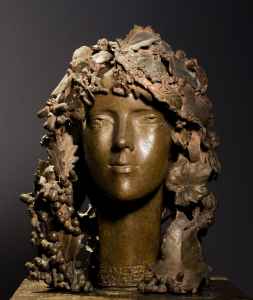
|
Belleza cubierta de hojas (ID#1272)
Skulptur
Bronze
49 x 40 x 20 cm
1981
verkäuflich (Preis auf Anfrage)
mehr Informationen
|
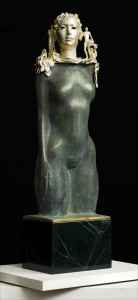
|
Mascara entera y mascara rota (ID#1245)
Skulptur
Bronze
51 x 17 x 13 cm
2005
verkäuflich (Preis auf Anfrage)
mehr Informationen
|
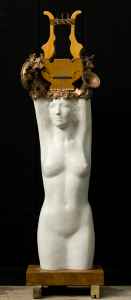
|
A Susana con flores y musica barroca (ID#1194 )
Skulptur
Stein
143 x 44 x 43 cm
2007
verkäuflich (Preis auf Anfrage)
mehr Informationen
|
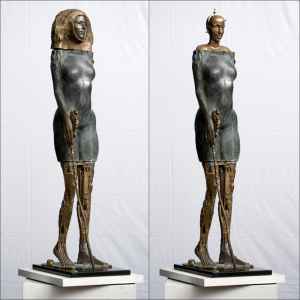
|
Tierra agua aire (ID#1192)
Skulptur
Bronze
82 x 25 x 20 cm
2006
verkäuflich (Preis auf Anfrage)
mehr Informationen
|
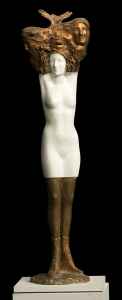
|
Maria y la comedia de la vida (ID#1191)
Skulptur
Bronze
105 x 29 x 22 cm
2005
verkäuflich (Preis auf Anfrage)
mehr Informationen
|
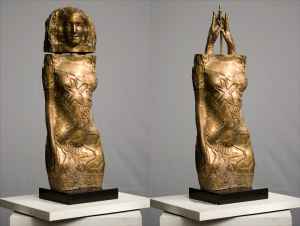
|
Mujer con manos y campana (ID#1189)
Skulptur
Bronze
51 x 20 x 10 cm
206
verkäuflich (Preis auf Anfrage)
mehr Informationen
|
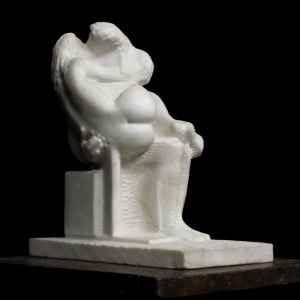
|
Besos con alma de bandoneon ID#(1117)
Skulptur
Stein
38 x 22 x 33 cm
2001
verkäuflich (Preis auf Anfrage)
mehr Informationen
|
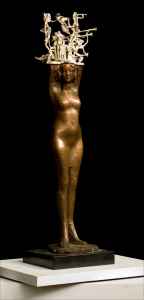
|
MAgnificat (ID#1109)
Skulptur
Bronze
57 x 14 x 11 cm
2005
verkäuflich (Preis auf Anfrage)
mehr Informationen
|
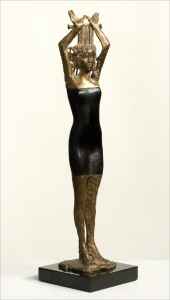
|
Paz y belleza (ID#1046)
Skulptur
Bronze
35 x 7 x 7 cm
2004
verkäuflich (Preis auf Anfrage)
mehr Informationen
|
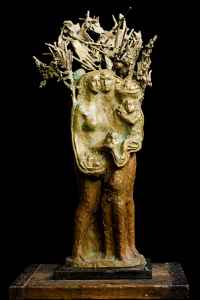
|
Seria de la familia 1 (ID#1038)
Skulptur
Bronze
62 x 19 x 14 cm
2003
verkäuflich (Preis auf Anfrage)
mehr Informationen
|
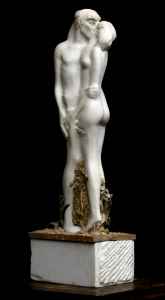
|
Amoryflores-ta (ID#1025)
Skulptur
Stein
70 x 22 x 16 cm
2002
verkäuflich (Preis auf Anfrage)
mehr Informationen
|
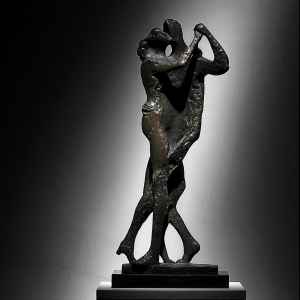
|
Tangazo (ID#795)
Skulptur
Bronze
60 x 22 x 10 cm
1990
verkäuflich (Preis auf Anfrage)
mehr Informationen
|
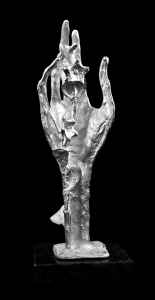
|
Mano de San Francisco
Skulptur
13 x 4 x 3 cm
1973
verkäuflich (Preis auf Anfrage)
mehr Informationen
|
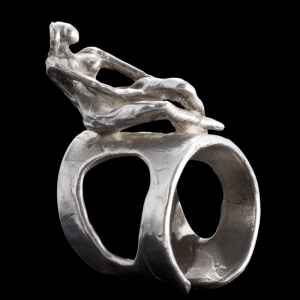
|
Desnudo al sol (ID#561)
Skulptur
2 x 2 x 1 cm
1972
verkäuflich (Preis auf Anfrage)
mehr Informationen
|
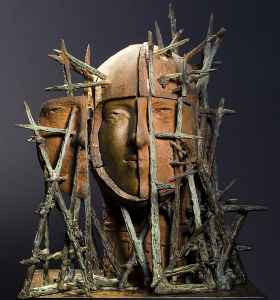
|
Belleza ofendida-defendida (ID#428)
Skulptur
Bronze
49 x 40 x 20 cm
1981
verkäuflich (Preis auf Anfrage)
mehr Informationen
|
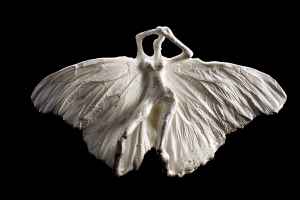
|
Mujer mariposa (ID#553)
Skulptur
2 x 3 x 1 cm
1973
verkäuflich (Preis auf Anfrage)
mehr Informationen
|
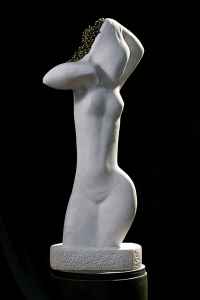
|
El amor de Amadeo (ID#494)
Skulptur
Stein
122 x 50 x 50 cm
1987
verkäuflich (Preis auf Anfrage)
mehr Informationen
|
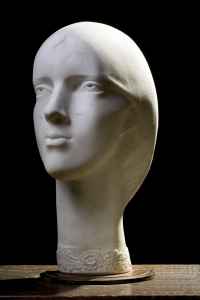
|
Pueza incontaminada (ID#425)
Skulptur
Stein
40 x 20 x 22 cm
1981
verkäuflich (Preis auf Anfrage)
mehr Informationen
|
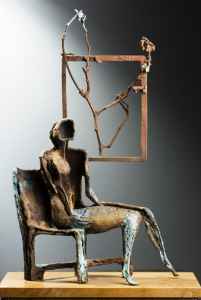
|
Ventana de la Primavera (ID#406)
Skulptur
Bronze
55 x 32 x 16 cm
1979
verkäuflich (Preis auf Anfrage)
mehr Informationen
|
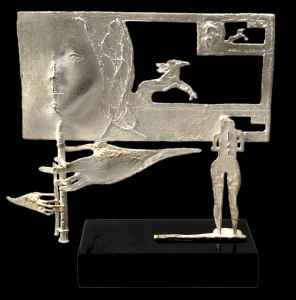
|
Concierto de flauta para un caballo
Skulptur
23 x 21 x 5 cm
1977
verkäuflich (Preis auf Anfrage)
mehr Informationen
|
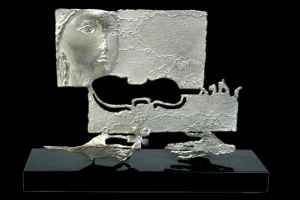
|
Violin ausente (ID#367)
Skulptur
14 x 16 x 2 cm
1976
verkäuflich (Preis auf Anfrage)
mehr Informationen
|
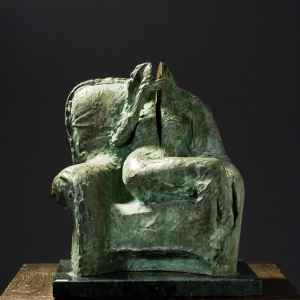
|
Empaquetada y dividida (ID#338)
Skulptur
Bronze
26 x 28 x 26 cm
1974
verkäuflich (Preis auf Anfrage)
mehr Informationen
|
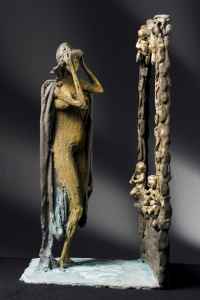
|
Mirarse en uno (ID#330)
Skulptur
Bronze
42 x 24 x 23 cm
1977
verkäuflich (Preis auf Anfrage)
mehr Informationen
|
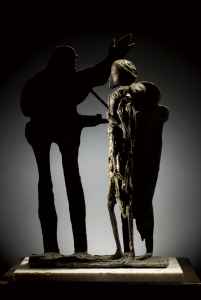
|
Es alta la sombra amenazante (ID#273)
Skulptur
Bronze
46 x 27 x 10 cm
1970
verkäuflich (Preis auf Anfrage)
mehr Informationen
|
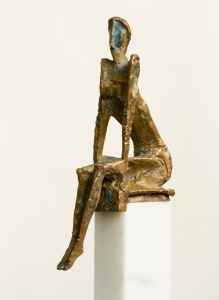
|
Bailarina sentada (ID#118)
Skulptur
Bronze
30 x 15 x 10 cm
1966
verkäuflich (Preis auf Anfrage)
mehr Informationen
|
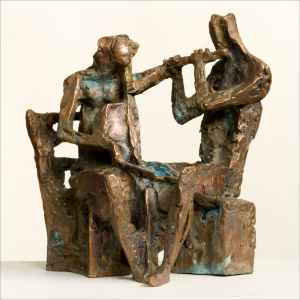
|
Los musicos (ID#102)
Skulptur
Bronze
26 x 27 x 15 cm
1965
verkäuflich (Preis auf Anfrage)
mehr Informationen
|
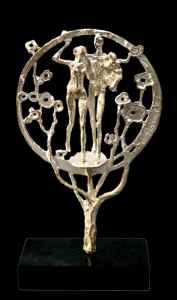
|
Pareja flores y frutos (ID#48)
Skulptur
13 x 8 cm
1997
verkäuflich (Preis auf Anfrage)
mehr Informationen
|
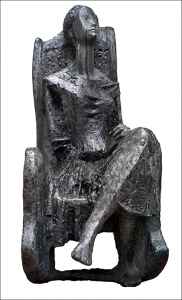
|
Adagio (ID#20)
Skulptur
Bronze
115 x 60 x 110 cm
1961
verkäuflich (Preis auf Anfrage)
mehr Informationen
|
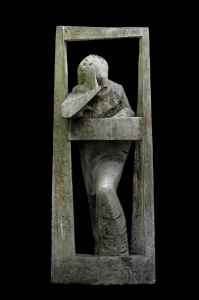
|
La mañana (ID#18)
Skulptur
200 x 74 x 60 cm
1961
verkäuflich (Preis auf Anfrage)
mehr Informationen
|
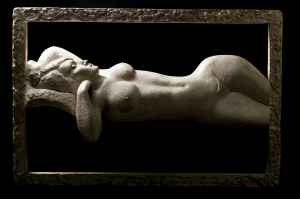
|
La paz (ID#462)
Skulptur
Gips
85 x 128 x 20 cm
1984
verkäuflich (Preis auf Anfrage)
mehr Informationen
|
|
 english
english
 español
español francais
francais
 russkii
russkii english
english
 español
español francais
francais
 russkii
russkii





























